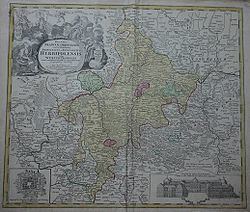 | ||
In the Holy Roman Empire the German term Hochstift ( [ˈhoːxˌʃtɪft]; plural: Hochstifte or, in some regions, Hochstifter) was often used to denote the territory of secular authority held by bishops ruling a prince-bishopric as their temporalities. The boundaries of secular prince-bishoprics did usually not correspond to that of the spiritual dioceses. Prince-bishoprics were always smaller than the dioceses which included (parts of) neighbouring imperial states such as principalities of secular princes and Free Imperial Cities. Prince-bishoprics could also include areas belonging in ecclesiastical respect to other dioceses.
"Das Stift" [plural die Stifte or, in some regions, die Stifter]/"het sticht" [in Dutch] (literally, the 'donation'), denotes in its original meaning the donated or else acquired fund of estates whose revenues are taken to maintain a college and the pertaining church (Stiftskirche, i.e. collegiate church) and its collegiate canons (Stiftsherr[en]) or canonesses (Stiftsfrau[en]). If the Stift as a fund served to maintain the specific college of a cathedral (a so-called cathedral chapter) then the Stift was often called "das Domstift" (i.e. cathedral donation [fund]).
If the chapter and/or the bishop of a cathedral managed not only to gain the estates and their revenues but also the feudal overlordship to them as a secular ruler with imperial recognition, such estates formed a territorial principality within the Holy Roman Empire with the rank of an imperial state. Each prince-bishop (Fürstbischof) or prince-archbishop (Fürsterzbischof) was thus also called a prince of the church, although the princely rank derived from imperial investiture.
"Hochstift" is a compound with "hoch" ("high") used for a prince-bishopric, meaning literally a high [ranking ecclesiastical] donation [fund of estates]. Whereas Erzstift, a compound with "Erz…" ("arch[i]…"), was the corresponding expression for a prince-archbishopric. For the three prince-electorates of Cologne (Kurköln), Mainz (Kurmainz) and Trier (Kurtrier), which were simultaneously archbishoprics the corresponding term is Kurerzstift (electorate-archbishopric). The adjective pertaining to Stift as a territory is stiftisch (of, pertaining to a prince-bishopric; prince-episcopal). As a component the term Stift today usually takes the copulative "s" when used as a preceding compound, such as in Stiftsadel (vassal nobility of a prince-bishopric), Stiftsamtmann (=official of a Stift), Stiftsmann (plural: Stiftsleute; =vassal tenant of an estate of a Stift), Stiftssasse (=subject/inhabitant of a prince-bishopric), Stiftsstände (=estates of a prince-bishopric as a realm), or Stiftstag (diet of the estates of a prince-bishopric).
Specific prince-bishoprics were often called "Hochstift/Erzstift X", as in "Hochstift Ermland" or in "Erzstift Bremen", with stiftbremisch meaning of/pertaining to the Prince-Archbishopric of Bremen, as opposed to stadtbremisch (of/pertaining to the city of Bremen). Whereas the spiritual entities, the dioceses, are called in German "Bistum" (diocese) or "Erzbistum" (archdiocese). The difference between a Hochstift/Erzstift and a Bistum/Erzbistum is not always clear to authors so that non-scholarly texts often translate Hochstift or Erzstift incorrectly simply as diocese/bishopric or archdiocese/archbishopric, respectively.
